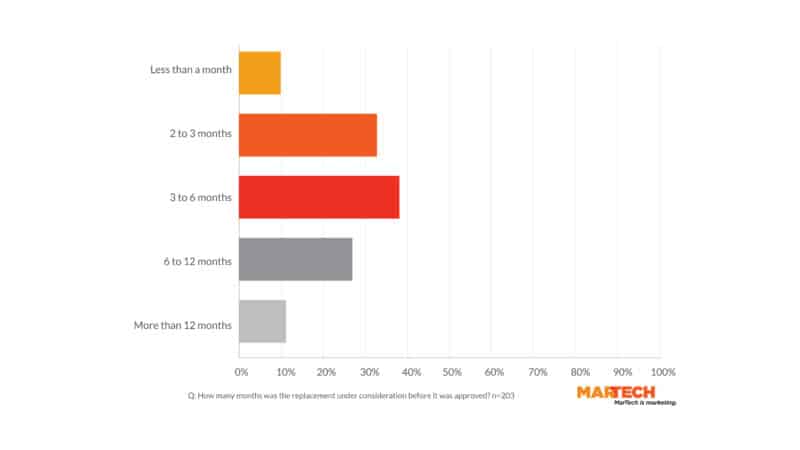
Marketing organizations make changes to their martech stacks all the time. After all, there are more than 14,000 martech applications on the market, and licenses are constantly coming up for renewal.
We all know there’s no such thing as a “typical” martech app replacement. If you work in B2B marketing, you’re well aware of the complexity of the B2B purchase process, especially in B2B tech. License renewals are one event that leads to replacing an application, but so do other changes, like new leadership, mergers and acquisitions and more.
The 2024 MarTech Replacement Survey asked marketers about the martech applications they replaced in the previous year. We can use its findings to give us some insight into what happens within marketing organizations when the decision is made to replace an application in the martech stack.
Martech replacements start with marketing management
Survey respondents told us the most common champions for martech replacements were people in marketing management. The marketing managers are followed by executive management, then marketing operations. Marketing staff and IT were less likely to champion a change in martech applications.
Martech replacements appear to have a top-down motion, as opposed to a bottom-up motion, where the staff and users of the product push for a replacement. It will vary from organization to organization, of course.
Martech applications get replaced because of the features
What is it that sends marketing leaders and their staffs looking for replacement to their existing martech applications? It is the features of the application, and this is true whether the application they’re looking to replace is a commercial application or a homegrown application.
In fact, the 2025 MarTech Replacement Survey found homegrown martech applications are becoming a rare breed. In 96% of the replacements respondents reported in the survey, the replacement application was a commercial application. As seen below, respondents cited a number of reasons for replacing homegrown solutions, but features were far and away the No. 1 response.
Features were the top reason to search for replacements when a commercial application was involved as well. But costs and integrations were also considerations.
Cost is the top factor when considering replacement apps
Cost was not the top reason cited by survey respondents when they were looking to replace a martech application, but when it was time to consider replacement apps, cost was the No. 1 factor for survey respondents in 2024.
We can group the most important factors for replacement applications into three categories:
- Financial, including costs and ROI measurement.
- Data, including integrations, APIs and data centralization.
- Improved customer experience.
The replacement process takes about 3 to 6 months
B2B purchase decisions are notoriously complicated. With numerous stakeholders, from the end users to their manager and roles like finance and, legal and procurement that have little relationship with the use of the product, coming to a decision can take months. And the more costly and complex the purchase, the longer it tends to take.
Fortunately for marketers, many of the martech tools available today are SaaS software products used by specific users in marketing or marketing operations.
The 2024 MarTech Replacement Survey found the replacement process takes, on average, about three to six months. It’s more likely the process is completed in six months or less than it is to extend beyond six months. This is in line with previous editions of the survey, showing that the timeline is neither slowing or speeding up.

The apps get replaced, but the team remains the same
Once a purchase decision is made and the new application is ready for use, marketing teams are re-training the same staff members on the new application. The survey found it’s relatively rare for a new team to be brought in due to a martech solution replacement.
The ‘typical’ martech app replacement looks like this
This is how a martech replacement happens, according to the 2024 MarTech Replacement Survey.
- Marketing management starts the process.
- Software features are what sets the process in motion.
- Costs are the most important factor when looking at replacement applications.
- The replacement process takes about three to six months.
- The new application is used by the same team that used the old application.
Download the full report for the 2024 MarTech Replacement Survey, no registration required.
The post This is what the ‘typical’ martech replacement looks like appeared first on MarTech.









